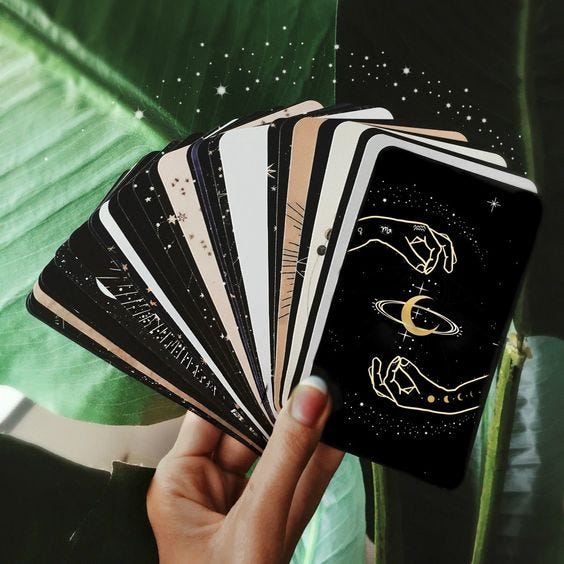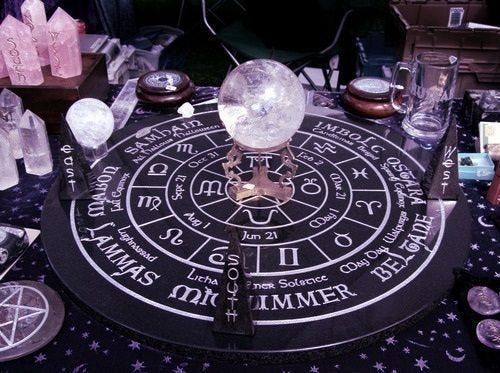Algorithmic power, connection addiction and class struggle. A future scenario at the crossroad between ICT and bio-tech evolution
February 14, 2020Embedded Will Be he Future Of Health And Fitness Experiences
February 21, 2020A story by Luca Fischer
We live in a world and society dominated by tech, The Internet and factual knowledge that we can access wherever, whenever. But it’s not solely these undisputed information the young are interested in. Because we also live in a world and society with social-cultural, ecological and political inequalities and challenges, wishing things would be different. Today’s story is about how Millennials and Gen-Z find support and comfort in spirituality, and why that is important.
The revival of astrology and tarot

Mercury in retrograde, new moon, affirmations, Saturn in Pisces. These are some of many popular terms in (modern) astrology. Astrology is like a blueprint of someone’s personality, determined by the position of the planets, the sun and moon at the very moment said person was born. Tarot offers a symbolic map of insights in their current direction of life, offering new information about how they could move forward. It’s not about predicting the future for themselves, like traditional horoscopes and Astro-TV often propagate. On the contrary, they use it as a tool to understand their here-and-now, their place in society and the ongoing challenges and pressure these generations are facing.
It is hard to pinpoint when exactly this rediscovery has started, as spirituality has never fully disappeared. Magazines and online platforms still publish their yearly, monthly, even weekly or daily horoscopes. But there was a visible layer of dust on the subject, and a some time ago tweens and Millennials have polished it up again. Why?
Finding an inner compass
Millennial and journalist Emma van Meijeren, who has been interested in astrology since the age of twelve, uses the medium to create an inner compass, as well as to make her more at peace with current challenges society gives her. She rediscovered her interest in astrology by following astrologists like Chani Nicholas, a renowned and feministic astrologist. Nicholas’ messages are encouraging rather than actual predictions, which is an important difference between superficial tabloid-horoscopes and more in-dept ones. Being ideas instead of facts could be a characteristic Millennials are so drawn towards them. They encourage its reader to create a connection between personal experiences and external influences that seem set in stone. Because when young creatives look at the harsh reality, astrological information can make these facts appear more fluid, giving them inspiration to look at situations differently. “In a world where Donald Trump is president of the United States, and Kavanaugh judge of the Supreme Court, it doesn’t feel like a big step to believe in something ‘unreal’ like astrology” says van Meijeren in an article she wrote for Vice.
Characteristic of Generation Z is their constant state of activism. Being born and raised in a world that seems more rough than ever, being stripped down from comfort like a scholarship, this generation wants to take action and grows up with a sceptic and critical gaze towards the status-quo. They are extremely sensitive to political issues and strive for a continual ‘woke’ state. Like van Meijeren, Gen-Z uses astrology like a tool to gain insights in their personal state, to help make their world a better place.
Spirituality as a technology

Generation Z also grew up almost entirely with The Internet, so it’s no surprise this form of spirituality has become very digital — which is a good thing. Globalization and The Internet actually helped these forms of spirituality to thrive. From astrologists on YouTube, to digital readings and brith charts. It might seem like an odd combination and quite the contradiction, but in this day and age, spirituality is actually being used as a modern technology. Like the Internet, it is a dense network of information that is being used to get questions answered. Spiritual media like tarot and astrology work in that very same way, and young creatives use them as tools to get in touch with their intuition.
Astrology as pop-culture
This generation carries out this revival in a rather physical and material manner, creating a lucrative market for anything related to spirituality — or not. Tarot illustrations have been an inspiration for Dior’s resort collection of 2018 designed by Maria Grazia Chiuri, their limited-edition cards resulted in an increase of tarot sales worldwide. Millennial-orientated brand Urban Outfitters offers cosmic pattern tapestry, tea for Capricorns and a how-to-use-crystals-guide.
Creating a popular culture around spirituality within industries these generations are already familiar and comfortable with, they can be inspired by and communicate their interest in astrology in every way possible, creating a bigger audience for this practice.
Feminine spirituality
Astrology is being practiced mostly by women. While there are plenty of men interested in the subject, the aesthetics of this revival are mostly marketed towards females. Perhaps of the fact that men statistically are less interested in spirituality, or because women are biologically more emotional and therefore more open-minded towards it. Astrologist Nele Costers states that only 10 percent of her clientele consists of men, and that while they are interested in the subject, doing something like a reading is too far out of what they feel comfortable with.
Even though it doesn’t matter which gender you identify with, this modern form of spirituality does create an empowering and almost magical space for women, where they can come together, share their interests, ideas, personal stories and challenges. One of those platforms is The Hoodwitch on Instagram, with more than 455K followers. The founder, Bri Luna, uses it for exactly that purpose: empowering other women. “They are finding their own strength and independency, distance themselves more and more from social constructs, traditions and (political) systems curated by men.” According to Luna, this distance will leave space for feminine spirituality.
The future of spirituality
Spirituality, or as how young creatives have morphed it, is not a trend. It has been around for centuries, and it will be for the next ones. Maybe on a higher volume, perhaps a wider range, but never fully gone. It’s refreshing to see young creatives diving into spirituality and using it to inspire others, understand themselves and getting motivated to make the world a better place. Hear, hear!
How do you feel about spirituality and the way Millennials and Gen-Z have been adopting this practice?
This is a story of the Futurist Club
By Science of the Time
Written by: Luca Fischer

Luca (22) recently graduated from Trend Research and Concept Creation in Lifestyle, where she wrote her thesis about intimacy among mentally impaired youth, and how technology can improve their quality of life by adding it to this basic human instinct. Her conceptual ideas and speculative future gaze is substantiated with a philosophical and ethical framework: “When looking at multiple futures, it’s not just about confirming a direction, but also about the provoking question — what it will mean for a culture, sector or lifestyle — and how ethically correct that future is going to be.” Currently, she works as a freelance allround creator and lives in Tilburg. A few of her former projects include a function as visual direction for start-up lifestyle brand PureSan, and a function as editor-in-chief of a local lifestyle magazine.



